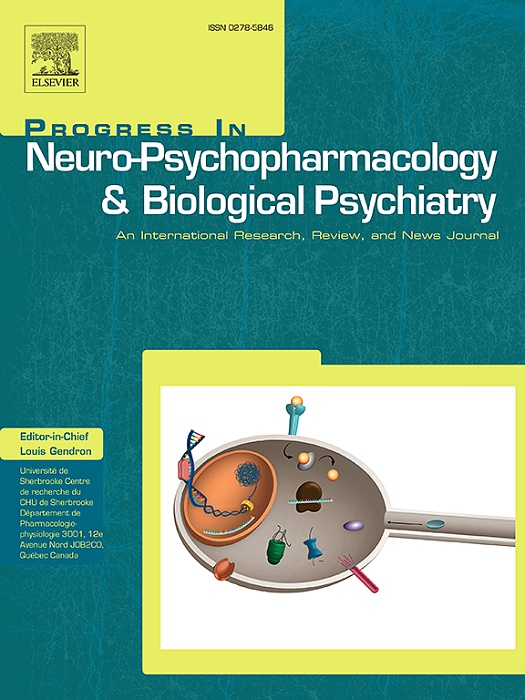Combined cognitive assessment and automated MRI volumetry improves the diagnostic accuracy of detecting MCI due to Alzheimer's disease
IF 5.3
2区 医学
Q1 CLINICAL NEUROLOGY
Progress in Neuro-Psychopharmacology & Biological Psychiatry
Pub Date : 2024-09-29
DOI:10.1016/j.pnpbp.2024.111157
引用次数: 0
Abstract
Background
Mild cognitive impairment (MCI) confers a high annual risk of 10–15 % of conversion to Alzheimer's disease (AD) dementia. MRI atrophy patterns derived from automated ROI analysis, particularly hippocampal subfield volumes, were reported to be useful in diagnosing early clinical stages of Alzheimer's disease.
Objective
The aim of the present study was to combine automated ROI MRI morphometry of hippocampal subfield volumes and cortical thickness estimates using FreeSurfer 6.0 with cognitive measures to predict disease progression and time to conversion from MCI to AD dementia.
Methods
Baseline (Neuropsychology, MRI) and clinical follow-up data from 62 MCI patients were analysed retrospectively. Individual cortical thickness and volumetric measures were obtained from T1-weighted MRI. Linear discriminant analysis (LDA) of both, cognitive measures and MRI measures (hippocampal subfields, temporal and parietal lobe volumes), were performed to differentiate MCI converters from stable MCI patients.
Results
Out of 62 MCI patients 21 (34 %) converted to AD dementia within a mean follow-up time of 74.7 ± 36.8 months (mean ± SD, range 12 to 130 months). LDA identified temporal lobe atrophy and hippocampal subfield volumes in combination with cognitive measures of verbal memory, verbal fluency and executive functions to correctly classify 71.4.% of MCI subjects converting to AD dementia and 92.7 % with stable MCI. Lower baseline GM volume of the subiculum and the superior temporal gyrus was associated with faster disease progression of MCI converters.
Conclusion
Combining cognitive assessment with automated ROI MRI morphometry is superior to using a single test in order to distinguish MCI due to AD from non converting MCI patients.
认知评估与自动磁共振成像容积测量相结合,提高了检测阿尔茨海默病导致的 MCI 的诊断准确性。
背景:轻度认知障碍(MCI)每年有 10-15% 的高风险转化为阿尔茨海默病(AD)痴呆。据报道,通过自动 ROI 分析得出的 MRI 萎缩模式,尤其是海马亚区体积,有助于诊断阿尔茨海默病的早期临床阶段:本研究旨在将使用 FreeSurfer 6.0 进行的海马子野体积和皮质厚度估算的自动 ROI MRI 形态测量与认知测量相结合,以预测疾病进展和从 MCI 向 AD 痴呆症转化的时间:对62名MCI患者的基线(神经心理学、核磁共振成像)和临床随访数据进行了回顾性分析。从 T1 加权核磁共振成像中获得了单个皮层厚度和容积测量值。对认知测量和 MRI 测量(海马亚区、颞叶和顶叶容积)进行线性判别分析(LDA),以区分 MCI 转换者和稳定型 MCI 患者:62 名 MCI 患者中有 21 人(34%)在平均 74.7 ± 36.8 个月(平均 ± SD,范围为 12 至 130 个月)的随访时间内转为 AD 痴呆。LDA结合言语记忆、言语流畅性和执行功能的认知测量,确定了颞叶萎缩和海马亚区体积,从而正确地将71.4%的MCI受试者和92.7%的稳定型MCI受试者归类为AD痴呆症患者。脑下凹和颞上回基线GM体积较低与MCI转换者疾病进展较快有关联:结论:将认知评估与自动ROI核磁共振成像形态测量相结合,比使用单一测试方法更能区分AD导致的MCI和非转换型MCI患者。
本文章由计算机程序翻译,如有差异,请以英文原文为准。
求助全文
约1分钟内获得全文
求助全文
来源期刊
CiteScore
12.00
自引率
1.80%
发文量
153
审稿时长
56 days
期刊介绍:
Progress in Neuro-Psychopharmacology & Biological Psychiatry is an international and multidisciplinary journal which aims to ensure the rapid publication of authoritative reviews and research papers dealing with experimental and clinical aspects of neuro-psychopharmacology and biological psychiatry. Issues of the journal are regularly devoted wholly in or in part to a topical subject.
Progress in Neuro-Psychopharmacology & Biological Psychiatry does not publish work on the actions of biological extracts unless the pharmacological active molecular substrate and/or specific receptor binding properties of the extract compounds are elucidated.

 求助内容:
求助内容: 应助结果提醒方式:
应助结果提醒方式:


